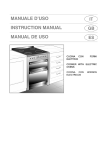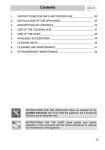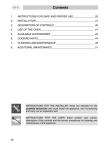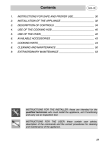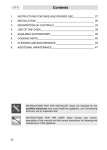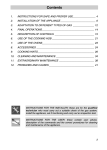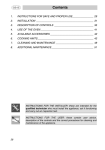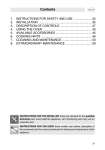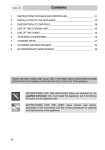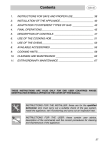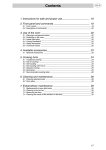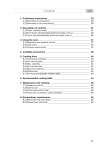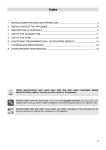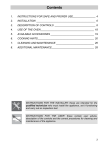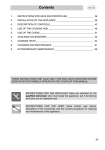Download Smeg A1C Instruction Manual
Transcript
Contents 1. INSTRUCTIONS FOR SAFE AND PROPER USE _______________29 2. INSTALLATION OF THE APPLIANCE ________________________31 3. DESCRIPTION OF CONTROLS _____________________________33 4. USE OF THE COOKING HOB _______________________________38 5. USE OF THE OVEN_______________________________________40 6. AVAILABLE ACCESSORIES ________________________________41 7. COOKING HINTS_________________________________________42 8. CLEANING AND MAINTENANCE ____________________________48 9. EXTRAORDINARY MAINTENANCE __________________________51 INSTRUCTIONS FOR THE INSTALLER: these are intended for the qualified technician who must install the appliance, set it functioning and carry out an inspection test. INSTRUCTIONS FOR THE USER: these contain user advice, description of the commands and the correct procedures for cleaning and maintenance of the appliance. 28 Introduction 1. INSTRUCTIONS FOR SAFE AND PROPER USE THIS MANUAL IS AN INTEGRAL PART OF THE APPLIANCE AND THEREFORE MUST BE KEPT IN ITS ENTIRETY AND IN AN ACCESSIBLE PLACE FOR THE WHOLE WORKING LIFE OF THE COOKER. WE ADVISE READING THIS MANUAL AND ALL THE INSTRUCTIONS THEREIN BEFORE USING THE COOKER. INSTALLATION MUST BE CARRIED OUT BY QUALIFIED PERSONNEL IN ACCORDANCE WITH THE REGULATIONS IN FORCE. THIS APPLIANCE IS INTENDED FOR DOMESTIC USES AND CONFORMS TO CURRENT REGULATIONS IN FORCE. THE APPLIANCE HAS BEEN BUILT TO CARRY OUT THE FOLLOWING FUNCTIONS: COOKING AND HEATING-UP OF FOOD. ALL OTHER USES ARE CONSIDERED IMPROPER. THE MANUFACTURER DECLINES ALL RESPONSIBILITY FOR IMPROPER USE. DO NOT LEAVE THE PACKING IN THE HOME ENVIRONMENT. SEPARATE THE VARIOUS WASTE MATERIALS AND TAKE THEM TO THE NEAREST SPECIAL GARBAGE COLLECTION CENTRE. IT IS OBLIGATORY FOR THE ELECTRICAL SYSTEM TO BE GROUNDED ACCORDING TO THE METHODS REQUIRED BY SAFETY RULES. THE PLUG TO BE CONNECTED TO THE POWER CABLE AND THE SOCKET MUST BE THE SAME TYPE AND MUST CONFORM TO CURRENT REGULATIONS. THE SOCKET MUST BE ACCESSIBLE AFTER THE APPLIANCE HAS BEEN BUILT IN. NEVER UNPLUG BY PULLING ON THE CABLE. IMMEDIATELY AFTER INSTALLATION CARRY OUT A BRIEF INSPECTION TEST OF THE APPLIANCE, FOLLOWING THE INSTRUCTIONS BELOW. SHOULD THE APPLIANCE NOT FUNCTION, DISCONNECT IT FROM THE SUPPLY AND CALL THE NEAREST TECHNICAL ASSISTANCE CENTRE. NEVER ATTEMPT TO REPAIR THE APPLIANCE. ALWAYS CHECK THAT THE CONTROL KNOBS ARE IN THE POSITION 0 (OFF) WHEN YOU FINISH USING THE HOB. 29 Introduction NEVER PUT INFLAMMABLE OBJECTS IN THE OVEN: THEY COULD BE ACCIDENTALLY LIGHTED AND CAUSE FIRES. THE I.D. PLATE WITH TECHNICAL DATA, REGISTRATION NUMBER AND BRAND NAME IS POSITIONED VISIBLY IN THE STORAGE COMPARTMENT. THE PLATE MUST NOT BE REMOVED. DO NOT INSTALL THIS APPLIANCE ON A RAISED PLATFORM DURING USE THE APPLIANCE BECOMES VERY HOT. TAKE CARE NOT TO TOUCH THE HEATING ELEMENTS INSIDE THE OVEN. DO NOT PUT PANS WITHOUT PERFECTLY SMOOTH AND FLAT BOTTOMS ON THE COOKING HOB GRIDS. NEVER USE THE COOKING HOB AS A WORK SURFACE. ATTENTION: IN CASE OF A CRACK BEING DETECTED IN THE GLAZED CERAMIC HOB, IMMEDIATELY DISCONNECT FROM MAINS AND CONTACT THE NEAREST SERVICING CENTRE. THE APPLIANCE IS DESIGNED FOR USE BY ADULTS. DO NOT ALLOW CHILDREN TO GO NEAR OR PLAY WITH IT. REPLACED APPLIANCES MUST BE TAKEN TO A SPECIAL GARBAGE COLLECTION CENTRE. The manufacturer declines all responsibility for damage to persons or things caused by non-observance of the above prescriptions or by interference with any part of the appliance or by the use of non-original spares. 30 Instructions for the installer 2. INSTALLATION OF THE APPLIANCE This unit is equipped with a type Y fire protection, and may be set against walls that are higher than the hob. 2.1 Electrical connection Make sure that the power line voltage matches the specifications indicated on the rating plate located inside the storage compartment. This rating plate must never be removed. On the power line, install an omnipolar cut-off device with contact cut-off distance greater than or equal to 3 mm, located in an easily accessible position near the unit. The appliance is fitted with a terminal board at the rear for electrical connections (see following diagram). To access, remove the rear cover. 31 Instructions for the installer For operation on 400-415V3N∼: use an 2 H05RR-F-type five-core cable (5 x 2.5 mm ). For operation on 400-415V2N∼: use an 2 H05RR-F-type four-core cable (4 x 4 mm ). For operation on 230-240V∼: use an 2 H05RR-F-type three-core cable (3 x 6 mm ). The cable end to be connected to the appliance must be provided with an ground wire (yellow-green) at least 20 mm longer. Complete wiring up to power supply with an appropriately rated five-core plug (see data plate) or, in case of operation from a 230V∼ ∼ power supply, with a three-core plug. Make sure that plug and wall socket are of the same type and are in conformity with regulations in force. Make sure that the appliance is properly earthed. Before powering, check that the power line is properly earthed. Avoid using adapters or shunters. The manufacturer declines all responsibility for damage to persons or things caused by non-observance of the above prescriptions or by interference with any part of the appliance. 2.2 Levelling Adjust the four feet so as to set the appliance on a perfectly level plane. For this purpose, loosen the lock nut and unscrew the foot. The range of adjustment of the screw is 10 mm. 32 Instructions for the user 3. DESCRIPTION OF CONTROLS 3.1 Front control panel All the cooker controls and commands are on the front panel. Before using the oven check that the electronic programmer is showing the symbol ; see paragraph “3.2.1 Clock adjustment”. DESCRIPTION OF SYMBOLS OVEN THERMOSTAT CENTRAL COOKING ZONE OVEN FUNCTIONS REAR RIGHT-HAND COOKING ZONE FRONT LEFT-HAND COOKING ZONE FRONT RIGHT-HAND COOKING ZONE REAR LEFT-HAND COOKING ZONE THERMOSTAT KNOB Selection of cooking temperature is carried out by turning the knob clockwise to the required temperature, between 50° and 250°C. The tell-tale light comes on to indicate that the oven is warming up. When it goes out it means that the required temperature has been reached. Regular flashing means that oven temperature is being constantly maintained at the programmed level. COOKING HOB SIGNAL LAMP (A) Signal lamp A on indicates that one or more of the cooking zones are heating. When all knobs are set to 0, the lamp goes off. 33 Instructions for the user FUNCTION SWITCH KNOB Turn the knob to select from the following functions: NO FUNCTION SET OVEN LIGHT GRILL ELEMENT + VENTILATION UPPER AND LOWER HEATING ELEMENT LOWER HEATING ELEMENT + VENTILATED HEATING ELEMENT GRILL ELEMENT VENTILATED HEATING ELEMENT + VENTILATION COOKING HOB CONTROL KNOB Standard heating The circle next to each knob indicates the cooking zone it controls. To heat, turn the knob to the desired position (1 to 9). Adjustment is continuous so that the appliance also operates at any intermediate value. To turn off, return the knob to 0. Double heating The circle next to each knob indicates the cooking zone it controls. To heat the inner cooking zone, turn the knob to the desired position (1 to 9). To heat both the inner and outer cooking zones, turn the knob to or and then release. The knob will thus return to 9. To adjust heating intensity, rotate the knob anticlockwise to the desired position. To return to heating of the inner cooking zone only, set the knob back to 0 and then turn to the desired position (1 to 9). To switch off, return knob to 0. 34 Instructions for the user 3.2 Electronic Programmer LIST OF FUNCTIONS MINUTE-COUNTER KEY COOKING TIME KEY END-OF-COOKING KEY DECREASE TIME KEY INCREASE TIME KEY 3.2.1 Clock adjustment When using the oven for the first time, or after a power failure, the display flashes regularly and indicates . Press the keys and at the same time the keys o : each single press changes the time by 1 minute either up or down. Before setting the programmer activate the desired function and temperature. 3.2.2 Semiautomatic cooking Use this setting for automatic oven switch-off at the end of cooking time. 35 Instructions for the user By pressing key , the display lights up, showing ; keep the key o to set the cooking pressed and at the same time, press keys time. Release key to start the programmed cooking time count. The display . will now show the right time together with symbols A and 3.2.3 Automatic cooking Use this setting to automatically start and stop the oven. , the display lights up showing ; keep the key By pressing key pressed and at the same time, press keys or to set the cooking time. By pressing key the sum of the right time + cooking time will appear; keep the key pressed and at the same time, press keys o to regulate the end of cooking time. Release key to start the programmed count and the display will show . the right time together with symbols A and After set-up, to see the cooking time remaining, press the key ; to see the end of cooking time press the key . Set-up with incoherent values is logically prevented (e.g. the contrast between a cooking time and a longer period will not be accepted by the programmer). 3.2.4 End of cooking When cooking is over, the oven will automatically switch off and, at the same time, an intermittent alarm will sound. After switching off the alarm, the display will once again show the right time together with the symbol , indicating that the oven has returned to manual operation mode. 36 Instructions for the user 3.2.5 Adjusting alarm volume The acoustic alarm has three different settings. These can be operated, while the alarm is sounding, by pressing key . 3.2.6 Switching off the alarm The alarm switches off automatically after seven minutes. They can be manually de-activated by pressing the keys and together. 3.2.7 Minute Counter The programmer can also be used as a simple minute counter. By pressing key , the display shows ; keep the key pressed and at the same time press keys o . On releasing the key , programmed counting will begin and the display will show the current time and the symbol . After set-up, to see the remaining time, press the key . Use as a minute counter does not interrupt functioning of the oven at the end of the programmed time. 3.2.8 Cancellation of set data Once the programme has been set, keep the key of the function to be is reached by means cancelled pressed, while at the same time of variation keys o . Time cancellation will be considered as end-ofcooking time by the programmer. 3.2.9 Changing the set data The cooking data entered can be changed at any time by keeping the function key pressed and at the same time adjusting the keys o . 37 Instructions for the user 4. USE OF THE COOKING HOB 4.1 Cooking zones The appliance features 5 cooking zones of different diameter and power. Their position is clearly indicated by circles and the heat given off is defined by the markings on the glass surface. The 5 cooking zones are of the HIGH-LIGHT type and come on after a few seconds of being activated. Heating intensity can be adjusted by means of the knobs located on the front panel from a minimum setting of 1 to a maximum setting of 9. The cooking zones marked by two concentric circles ( ) and by a circle + fish-kettle ( ) feature double heating either within the inner circle or both circles. The five signal lamps located between the cooking zones come on when the temperature of one or more of the heating zones exceeds 60°C. The lamps go off upon temperature dropping to below approximately 60°C. When using for the first time, it is advisable to heat up the cooking hob to its maximum temperature for enough time so as to burn off any possible oily manufacturing residues, the smell of which could otherwise be absorbed by the food. For best results and energy saving, only use receptacles suitable for electric cooking: • The bottom of the receptacles must be very thick and perfectly flat; before placing on the cooking hob, make sure that it, as well as the cooking hob itself, are perfectly clean and dry. • To avoid scratching of the cooking hob, never use cast-iron receptacles or receptacles with a rough bottom. • To avoid waste of energy, make sure that the diameter of the receptacle bottom is the same as that of the circle marked on the cooking hob. 38 Instructions for the user Take care not to spill sugar or sweet mixtures on to the cooking hob when hot. Never place materials or substances which may melt (plastic or aluminium foil) on to the cooking hob. In the event, promptly switch off and remove the molten material with the scraper provided while the top is still warm to prevent it from being damaged. Failure to instantly clean the glazed ceramic hob could lead to encrustations which are impossible to remove once the hob has cooled down. Important. Beware of children in the vicinity as the signal lamps indicating residual heat are out of sight to them. In fact, even after having been turned off, the cooking hob remains hot for a certain period of time. Make sure that children never touch the cooking hob. 4.2 Cooking tips The following table shows the knob setting according to the type of food to be cooked or heated. Setting may vary depending on the amount of food and personal taste. KNOB SETTING 1 TYPE OF FOOD TO MELT BUTTER, CHOCOLATE, AND THE LIKE. 2-3 TO HEAT FOOD, KEEP SMALL AMOUNTS OF WATER ON THE BOIL, AND WHIP UP SAUCES WITH EGG YOLK OR BUTTER. 4-5 TO HEAT SOLID OR LIQUID FOOD, KEEP SMALL AMOUNTS OF WATER ON THE BOIL, THAW DEEP-FROZEN FOOD, COOK OMELETTES OF 2 OR 3 EGGS, FRUIT AND VEGETABLES, AND THE LIKE. 6 TO STEW MEAT, FISH AND VEGETABLES, SIMMER FOOD, MAKE JAMS, AND SO ON. 7-8 TO ROAST MEAT, FISH, STEAKS, AND LIVER; TO SAUTÉ MEAT, FISH, EGGS AND SO ON. 9 TO DEEP-FRY POTATOES, ETC AND TO QUICK-BOIL WATER. 39 Instructions for the user 5. USE OF THE OVEN 5.1 Warnings and general advice Before using the oven for the first time, pre-heat it to maximum temperature (250°C) long enough to burn any manufacturing oily residues which could give the food a bad taste. After a power failure, the display will flash at regular intervals showing . To regulate, refer to paragraph "3.2 Electronic Programmer”. During cooking, do not cover the bottom of the oven with aluminium or tin foil and do not place pans or oven trays on it as this may damage the enamel coating. If you wish to use greaseproof paper, place it so that it will not interfere with the hot air circulation inside the oven. To prevent any steam in the oven creating problems, open the door in two stages: half open (5 cm approx.) for 4-5 seconds and then fully open. To access food, always leave the door open as short a time as possible to prevent the temperature in the oven from falling and ruining the food. 5.2 Oven Light It comes on when the function switch knob is turned to any position. 5.3 Storage compartment A storage compartment, accessible by pulling on the top edge of the door, is located beneath the oven. Never store inflammable materials such as rags, paper or the like. The compartment is intended only for holding the metal accessories of the range. 40 Instructions for the user 6. AVAILABLE ACCESSORIES The oven features 4 support positions for plates and racks of different height. Oven grill: for cooking food on plates, small cakes, roasts or food requiring light grilling. Plate grill: for placing above plate for cooking foods that might drip. Oven plate: useful for catching fat from foods on the grill above. Pastry plate: for baking cakes, pizza and oven desserts. Roasting spit: useful for cooking chicken, sausages and anything else requiring uniform cooking over the whole surface. Spit supports: to be inserted in the holes of the oven plate before mounting the roasting spit. Accessories on Request You can order the lower base and self-cleaning oven panels through Authorised Assistance Centres. 41 Instructions for the user 7. COOKING HINTS In fan-assisted mode preheating should be carried out at 30/40°C above the cooking temperature. This considerably shortens cooking times and reduces power consumption, as well as giving better cooking results. Keep the oven door closed during cooking 7.1 Traditional cooking FUNCTION SWITCH THERMOSTAT SELECTOR SWITCH FROM 50° TO 250°C This traditional cooking method, in which heat comes from above and below, is suitable for cooking food on a single level. You have to preheat the oven until the set temperature is reached. Place the food in the oven only after the thermostat indicator light has turned off. very fatty meats may be put in when the oven is still cold. Put frozen meat in immediately, without waiting for it to thaw. The only precaution you need to take is to set the temperature about 20°C lower and cooking time about 1/4 longer than you would for fresh meat. Use high-rim pans to prevent fat splashing and dirtying the sides of the oven. 42 Instructions for the user 7.2 Hot-air cooking FUNCTION SWITCH THERMOSTAT SELECTOR SWITCH FROM 50° TO 250°C This system is suitable for cooking on several levels, including different types of food (fish, meat etc.), without the tastes and smells mingling. Air circulation in the oven ensures a uniform distribution of heat. Pre-heating is not necessary. Multiple cooking is possible as long as the cooking temperature of the different foods is the same. 7.3 Grill cooking FUNCTION SWITCH THERMOSTAT SWITCH AT MAXIMUM Permits rapid browning of foods. You are advised to place the pan in the highest guide. For short-term cooking of small quantities, place the grid in the third guide from the bottom. For long-term cooking and grills, put the grid in the lowest guide in accordance with the size of the pieces. Make sure that the oven door is closed during cooking. 43 Instructions for the user 7.4 Hot-air grilling FUNCTION SWITCH THERMOSTAT SWITCH FROM 50° TO 200°C Ensures uniform heat distribution with greater heat penetration into the food. Food will be lightly browned on the outside and remain soft inside. Keep the oven door closed during cooking. Heating up time must not exceed 60 minutes. 7.5 Defrosting FUNCTION SWITCH THERMOSTAT SWITCH IN POSITION 0 The flow of air produced by the fan ensures quicker defrosting. The air circulating inside the oven is at room temperature. The advantage of defrosting at room temperature is that it does not alter the taste and appearance of the food. 44 Instructions for the user 7.6 Spit cooking FUNCTION SWITCH THERMOSTAT SWITCH AT MAXIMUM Insert the food to be cooked on to the rod and tighten screws A of the forks. Fit frames B into the holes of the bowl F. Remove handle D and position the spit rod so that pulley E fits into the slot on the right-hand side of frame B. Completely introduce the bowl into the oven until the tip of the rod of frame B on the left-hand side fits into drive seat C of the spit motor on the back wall of the oven. Pour a bit of water into the pan to avoid smoke from the dripping. Make sure that the oven door is closed during cooking. It is normal for the thermostat light to flash during cooking. This indicates the temperature inside the oven is regular. 45 Instructions for the user 7.7 Recommended cooking table Cooking times, especially meat, vary according to the thickness and quality of the food and to consumer taste. TRADITIONAL COOKING FIRST COURSES LASAGNE OVEN-BAKED PASTA MEAT ROAST VEAL ROAST BEEF ROAST PORK CHICKEN DUCK GOOSE - TURKEY RABBIT LEG OF LAMB ROAST FISH PIZZA DESSERTS MERINGUE SHORT PASTRY CIAMBELLA SAVOYARDS BRIOCHES FRUIT CAKE LEVEL FROM BELOW TEMPERATURE (°C) TIME IN MINUTES (*) 2-3 2-3 210 - 230 210 - 230 30 40 2 2 2 2 2 2 2 1 1-2 170 - 200 210 - 240 170 - 200 170 - 200 170 - 200 140 - 170 170 - 200 170 - 200 170 - 200 1-2 210 - 240 30 - 40 / KG. 30 - 40 / KG. 30 - 40 / KG. 45 - 60 45 - 60 45 - 60 50 - 60 15 / KG. ACCORDING TO DIMENSIONS 40 - 45 1-2 1-2 1-2 1-2 1-2 1-2 50 - 70 170 - 200 165 150 170 - 200 170 - 200 60 - 90 15 - 20 35 - 45 30 - 50 40 - 45 20 - 30 (*) = WITH PREHEATED OVEN GRILLING LEVEL FROM BELOW PORK CHOPS FILLET OF PORK FILLET OF BEEF LIVER VEAL ESCALOPES HALF CHICKEN SAUSAGES MEAT-BALLS FISH FILLETS TOAST 46 4 3 3 4 4 3 4 4 4 4 TIME IN MINUTES FIRST SURFACE 7-9 9 - 11 9 - 11 2-3 7-9 9 - 14 7-9 7-9 5-6 2-4 SECOND SURFACE 5-7 5-9 9 - 11 2-3 5-7 9 - 11 5-6 5-6 3-4 2-3 Instructions for the user HOT-AIR COOKING FIRST COURSES LASAGNE OVEN-BAKED PASTA CREOLE RICE MEAT ROAST VEAL ROAST PORK ROASTED BEEF FILLET OF BEEF ROAST LAMB ROAST BEEF ROAST CHICKEN ROAST DUCK ROAST TURKEY ROAST RABBIT ROAST HARE ROAST PIGEON FISH PIZZA DESSERTS (PASTRIES) CIAMBELLA FRUIT CAKE SPONGE-CAKE BRIOCHES STRUDEL SAVOYARD PUDDING BREAD TOAST LEVEL FROM BELOW TEMPERATURE (°C) TIME IN MINUTES 2 2 2 190 - 210 190 - 210 190 - 220 20 - 25 25 - 30 20 - 25 2 2 2 2 2 2 2 2 2 2 2 2 2-3 150 - 170 150 - 160 160 - 170 160 - 180 130 - 150 170 - 180 170 160 - 170 150 - 160 150 - 160 160 - 170 140 - 170 150 - 170 2-3 210 - 240 65 - 90 70 - 100 65 - 90 35 - 45 100 - 130 40 - 45 70 - 90 100 - 160 160 - 240 80 - 100 30 - 50 15 - 25 ACCORDING TO DIMENSIONS 30 - 50 2-3 2-3 2-3 2-3 1-2 2-3 2-3 1-2 150 - 170 170 - 190 190 - 220 160 - 170 150 160 - 170 190 - 210 220 - 240 35 - 45 40 - 50 25 - 35 40 - 60 25 - 35 30 - 40 40 7 47 Instructions for the user 8. CLEANING AND MAINTENANCE 8.1 Cleaning the glazed ceramic hob Before any intervention, disconnect the power supply of the device. The cooking hob should be regularly cleaned; best after every use, once the residual heat signal lamps have gone off. Smudges from aluminium-bottom pans can be easily cleaned off with a cloth dampened in vinegar. Remove any burnt residues after cooking with the scraper provided; rinse with water and wipe dry with a clean cloth. Regular use of the scraper considerably reduces the need for chemical detergents for the daily cleaning of the hob. Never use abrasive or corrosive detergents (e.g. cleaning powders, oven sprays, spot-removers, wire sponges). 8.2 Cleaning stainless steel 8.2.1 Ordinary Daily Cleaning To clean and preserve the stainless steel surfaces, always use only specific products that do not contain abrasives or chlorine-based acids. How to use: pour the product on a damp cloth and wipe the surface, rinse thoroughly and dry with a soft cloth or deerskin. 8.2.2 Food stains or residues Do not use metallic sponges or sharp scrapers: they will damage the surface. Use normal non-abrasive products for steel, and a wooden or plastic tool if necessary. Rinse thoroughly and dry with a soft cloth or deerskin. Do not allow residues of sugary foods (such as jam) to set inside the oven. If left to set for too long, they might damage the enamel lining of the oven. 48 Instructions for the user 8.3 Cleaning of the oven (without self-cleaning panels) For best oven upkeep clean regularly after having allowed to cool. Take out all removable parts. Detach the side guides by unscrewing ring nut A and sliding out of the rear hole B. • • Clean the oven grill and side guides with hot water and non-abrasive detergent. Rinse and dry. Clean the internal walls of the oven with a soft ammoniac-soaked cloth. Rinse and dry. If there are still stains or drops, place a damp ammoniac-soaked cloth on the bottom of the oven, close the door and after a few hours wash the oven with hot water and liquid detergent. Rinse and dry. 8.3.1 Self-cleaning liners The oven is equipped with continuous self-cleaning enamelled liners. These liners make the oven easier to clean and ensure its efficiency over time. 8.3.2 Using the self-cleaning liners Periodically, to prevent food residues and unpleasant smells from accumulating inside the oven, the appliance should be operated empty at temperatures of not less than 200°C for a time varying from 30 to 60 minutes, in order to allow the self-cleaning liners to oxidise the residues present; when the oven has cooled, these will then be removed with a damp sponge 49 Instructions for the user 8.3.3 Looking after the self-cleaning liners The liners should not be cleaned with abrasive creams or ordinary detergents. Use a damp sponge only, so as not to damage the special characteristics of the enamel which coats the liners. 8.3.4 Assembling the self-cleaning liners 1. 2. 3. 4. 5. Remove all accessories from the oven; Remove the side grilles (fig.1); Extract the side liners “F” and “G”(fig. 2); Remove the back panel “A” after undoing the threaded ring-nut “C” (fig. 2). Reassemble the panels, restoring them to their original position. 1) 2) 8.4 Door glass The door glass should always be kept clean. Use absorbent kitchen paper to clean. In case of tough spots, clean with a damp sponge using regular detergent. 50 Instructions for the user 9. EXTRAORDINARY MAINTENANCE The oven may require extraordinary maintenance or replacement of parts subject to wear such as seals, bulbs, and so on. The following instructions describe how to carry out these minor maintenance operations. Before any intervention, disconnect the power supply of the device. 9.1 Replacement of light bulb Remove cover A by twisting anticlockwise, replace bulb B with another similar bulb. Refit the cover A. Only use oven bulbs (T 300°C). 51 Instructions for the user 9.2 Removing the door Hold the door on both sides with both hands near hinges A and raise levers B. Lift up the door forming an angle of about 45° and remove. To refit, slide the hinges A in the grooves, drop the door and release levers B. 9.3 Oven door seal To permit thorough cleaning of the oven, the seal may be removed. Before removing the seal, take off the door as described above. Once the door has been taken off, lift the tabs at the corners as shown in the figure. 52

























